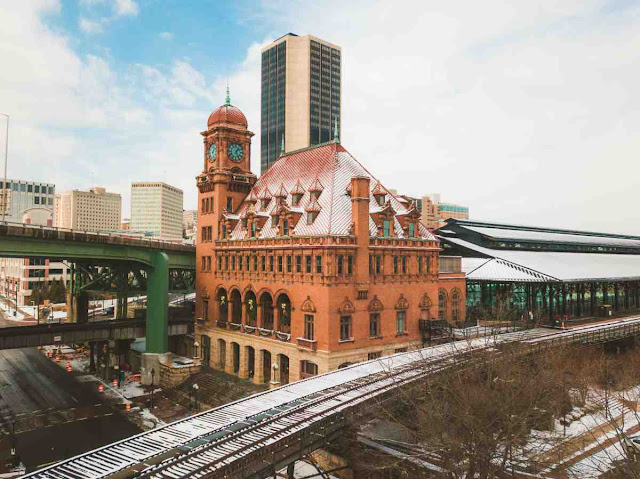The Little Hell Gate bridge was important, although it was smaller than the Hell Gate Bridge. So Lindenthal added the decorative end towers, but he made them less imposing than the end towers of the main Hell Gate bridge. And the videos indicate the towers are all that's visible from track level.
I need to add a 90-degree bend to the next stage of my T-TRAK layout, which although it's to T-TRAK physical standards, is not electrically compatible, although T-TRAK electrical standards for all but small module arrangements basically don't exist, and I don't intend to take most of my modules, if any ever, to a show.
So I was looking for prototypes that might somehow be used to justify a 90-degree turn in a passenger environment, while I was becoming more intrigued with the idea of Lindenthal's Little Hell Gate towers. Then inspiration struck: heading south, the Hell Gate route makes a near 90-degree left turn after the Little Hell Gate bridge to reach the main bridge:
So from my point of view, we're in T-TRAK world, where we're looking at modules with highly compressed vignettes. So I'm going to start with the southernmost pair of towers on the Little Hell Gate bridge and include the 90-degree turn afterward on a standard 12-inch radius module. The tower locations are shown in red below: This conveniently leaves out both the Little Hell Gate and the Hell Gate bridges, but it does include a section of viaduct running mainly over a park, and it gives me at least one pair of those towers, which fascinate me. What I plan to do is get a Masterpiece Modules kit for a standard 12-inch corner module with a depressed deck, on which I will use Kato viaduct track.For the towers, it should be fairly easy to come up with rough dimensions from screen shots at track level assuming the height from rail to the bottom of the catenary bar between the towers is 25 feet, and calculating their length and width using the track gauge in this down-on shot from Google Satellite:
Wooden balls in various sizes are available as craft items. I am thinking the closest size in N scale would be 3/8" or 7/16". I think I will build the towers themselves from sheet basswood, attach the balls to them with dowel, and build up the pagoda-style roofs with spackle.I think one of the Kato N scale catenary structure styles is close enough to use on the viaduct as well.


























